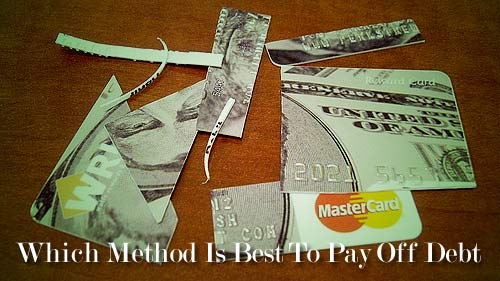There is frequently a debate between financial gurus as to what method of debt repayment is best.
Lowest Balance to Highest Balance
Of course, Dave Ramsey advocates the debt snowball method where you list your debts with the lowest balance to the highest balance with no concern for what the interest rates are. Then, you pay the minimum payment on every debt except the one with the lowest balance. The one with the lowest balance is the one on which you apply as much money as you can. Once that one is paid off, you take the payment that used to be applied to the debt you just paid off to your next debt with the next lowest balance. As this cycle continues, the amount you apply on the next card in line increases as you pay off your debts one by one, which is how your debt snowball becomes larger and more formidable.
Critics argue that Dave Ramsey’s approach is not cost effective—you pay more in interest by following the debt snowball method. Dave Ramsey argues that personal finance is not only about math, it is about psychology as well, and the psychological boost of seeing at least one of your debts disappear quickly helps greatly in debt repayment. There is real motivation from seeing immediate results.
Highest Interest Rate to Lowest Interest Rate
On the other hand, financial gurus argue that the most effective way to pay off debt is by paying the debt with the highest interest rate first, no matter how large or small that debt is. By paying off the debt with the highest interest rate, you are freeing yourself of a debt that takes more and more of your hard earned money simply for interest, rather than principal.
Recently, the April edition of Kiplinger’s included an essay by Robert Frick, senior editor at Kiplinger’s. He argues that we should pay off our cards based on the highest interest rate, but we don’t because “our brains aren’t adept at quickly calculating” the financial implications of paying the debt with the lowest balance first. He explains, “Think of $10,000 in credit card debt with an interest rate at the national average of 14.9%. You want to pay off that debt aggressively, so you figure you’ll pay 4% of the balance,or $400, on the card each month. Quick, how long will it take to pay it off? You may think, Twenty-five monthly payments would be $10,000 then add in some interest. The debt will disappear in a couple of years. In fact, you’ll be paying for 31 months and will rack up more than $2,400 in interest.”
Pick a Plan and Stick with It
Both parties make compelling points, but the argument reminds me a lot of weight loss. One person may advocate a low-carb diet while another may advocate a structured diet plan like Weight Watchers. Actually, if you stick to your weight loss plan, either plan will give you results because the bottom line is that you are consuming less than you previously did because you are following a plan.
Don’t struggle with which debt repayment plan is better—paying off the lowest debt first or paying off the highest interest rate first. The important decision here is to decide to pay off debt and make a plan for how you will tackle that debt.
My husband and I are taking a hybrid approach. We are paying down our debt first by category. Our priority is to first pay off all credit card debt before moving on to student loan debt, even though my student loan has a lower overall balance than one of our credit cards. We have been paying down the credit cards based on Dave Ramsey’s suggestion of paying down the lowest cards first. Doing this gave us an immediate shot of energy when we paid off the credit card with the lowest balance in the first month of becoming gazelle intense. Yet, following this method, we are saving the largest credit card, which is also the credit card with the highest interest rate, for last. Are we paying more in interest? Yes, but I stay motivated by seeing debt disappear.
When paying down debt, determine which strategy works best for you and then stick with the plan. Don’t concern yourself with how much interest you are paying, unless that motivates you to pay down debt more quickly. Instead, just focus on how you can pay down the debt, in the order that works for you, as fast as possible.



The best advice I’ve heard for finding a balance there (highest interest with the lowest balance) is start with the debt you are paying the least principal on. For me it turned out to be my highest interest rate.
When we were paying off debt I believe we did a hybrid approach of sorts where we would be paying off a couple of smaller $1000 debts first, and then moving on to the larger dollar debts – which we did in order of highest interest first.. It worked well for us – giving us the best of both worlds.
I think I would do highest interest rate first, just to save money overall. Psyching yourself up is all good and well, but in the end the dollars saved win out for me.
I prefer highest interest rate first. I enjoy calculating how much interest is coming out of my pocket just by waking up in the morning. At one point it was $7 in interest per day! Now it’s down to about $2.
It’s a good feeling knowing the banks aren’t making as much off me…
For those number crunchers out there – you could use Undebt.it to manage your debts. You can use either the snowball or avalache (highest interest) method.
What I do is look at the statements and put the most money toward the debt which incurs the highest amount of interest. This way, I’m not only paying down debt, but also preventing more interest from accumulating and adding to the balances. Of course, I don’t have a problem with not paying off a balance completely right away. I’m much more satisfied knowing that I’m saving on future interest charges but it’s not a plan for everyone.
I’ve been considering this, but this would have me paying on my mortgage first…
That’s an exclusion. Revolving debt is what it’s meant for–basically credit cards. The reason being is that only revolving debt keeps compounding new interest onto the balance to come up with a new amount. All other kinds are fixed interest amounts. Plus, when you can get student loan and mortgage at generally low rates combined with the tax deduction they usually provide, it’s best to keep those at their regular payments and concentrate on the rest that don’t offer you any benefit.
Good summary of the two camps. I’m in the debt snowball camp, but I’d be willing for a client to fudge a bit if they were sticking to their plan. The larger debts like student loans are almost like mortgages and good idea to pay off all unsecured debt first.
Hubby and I are in disagreement on this one. I think we should tackle the higher interest rates first, but he prefers to pay off lower balances first.
I will admit that his makes some sense since it’s a card we can eliminate altogether once it’s paid in full.